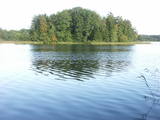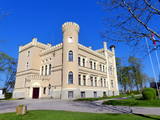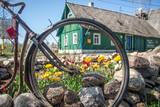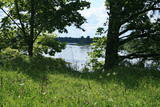| Nr | Nosaukums | Apraksts |
|---|---|---|
|
Litorīnas jūras laikā (pirms ~ 6000 gadiem) Saleveres Salumegi kalns bija sala, bet mūsdienās tas kā izteikta kāple (īpaši - ziemeļu pusē) paceļas virs Piejūras līdzenuma. Salumegi ziemeļu pusē slejas 4 - 5 metrus augsts kaļķakmens atsegums – silūra perioda (> 400 mlj. gadu) koraļļu rifa paliekas, kuru noskalojuši Litorīnas jūras viļņi. Atseguma piekājē izplūst Acu avots, kam piedēvē dziednieciskas īpašības. Salumegi apskates nolūkos izveidota lokveida taka (1,5 km). No kalna augšas paveras labs skats uz Matsalu līci. Šeit atradies arī sens pilskalns. |
||
|
Vidzemes augstienes centrālajā daļā esošā Jumurdas ezera, tā trīs salu ar platlapju mežiem un ainavas aizsardzības nolūkos veidots dabas liegums. Lieguma teritorija labi pārskatāma no Jumurdas muižas puses un no lieguma dienvidos esošo pauguru augstākajām daļām.
|
||
|
Gārsene – Kurzemes hercoga Gotharda Ketlera kroņa muižu Gārseni 1583. gadā nopirka no Vestfāles ienākušais Gorhards Beninghauzens – Budbergs. Viņa dzimta Gārsenē valdīja 340 gadus. Gārsene – Kurzemes hercoga Gotharda Ketlera kroņa muižu Gārseni 1583. gadā nopirka no Vestfāles ienākušais Gorhards Beninghauzens – Budbergs. Dzimta Gārsenē valdīja 340 gadus. Gārsenes pils - celta 1856. - 1860.g. neogotikas stilā. Pēc fon Budbergu dzimtas vēstures materiāliem, sākumā uzcelta pils divstāvīgā daļa, bet otrs, zemākais spārns, uzcelts 1885.g. 1939.g. ēka pārbūvēta skolas vajadzībām, un no 1940.g. līdz 2015.g. tajā atradās Gārsenes pamatskola. Pilī atrodas muzejs un ekspozīcija par baronu Budbergu dzimtu, Gārsenes vēsturi, un pamatskolas vēsturi. Pils telpās apskatāma podiņu krāsns, kas ir kultūrvēstures piemineklis. Krāsns fasādi grezno Holandē ražoti, ar jūras un vējdzirnavu ainavām apgleznoti zilbalti podiņi. 2016.gada maijā tika veikta podiņu krāsns restaurācija. Pils kompleksu ieskauj 4ha liels parks, dzirnavu dīķi un meža parkā atjaunotas un uzlabotas barona laika pastaigu takas, kas vijas gar Dienvidsusējas krastiem. Visas sezonas garumā pilī apskatāmas mākslas un izzinošās izstādes.
|
||
|
Amatas pagasta Dīķīšos viesus sagaidīs Samojedu šķirnes suņi un inteliģenti ēzelīši, kas aizvedīs līdz glempingam dīķīša pakājē. Piedāvā iznūjot divu garumu takas vai izbaudīt to iespēju, kad latvietis dalās sēņošanas un ogošanas vietās. Īpašs piedzīvojums ir glezu veidošana no mežā salasītiem dabas materiāliem. Kultūrvēstures interesenti var iepazīt latviešu tautas tērpu kolekciju, uzlaikot to un noorganizēt paši savu fotosesiju. Ekstrēmu izjūtu cienītājiem patiks izbrauciens ar kvadraciklu. Bet, ja patīk makšķerēt, var ņemt līdzi nepieciešamo inventāru. Organizē uguns rituālus gadskārtās un ģimenes godos. Tāpat saimnieki piedāvā arī uz ugunskura vārītu zupu un dažādu svaigā siera gatavošanas meistarklasi. Piedāvā nakšņot glempinga teltī. Naktsmājas ir piemērotas arī cilvēkiem ratiņkrēslā, t.sk. ar atbilstoši izbūvētu mazmājiņu! |
||
|
Dzirnavu restorāns Saaremaa ir sāremiešu iecienīto garšu restorāns, kur piedāvā visu to labāko un svaigāko. Ēdienkartē atrodama medījumu gaļa no Saaremaa mežiem, vasarā arī kūpinātas zivis, našķi no ogām, vietējo ābolu vīns, kā arī labākie Saaremaa salas vīni. |
||
|
"Sabiles laivas" Talsu novadā piedāvā laivu nomu, laivu un laivotāju transportu. |
||
|
Kopā ir ap 50 liellopiem, visa gada garumā tie ganās ārā, tādēļ tos var apskatīt jebkurā laikā. Ja ir iespēja, apmeklētāji var pacienāties ar „Hailandes” liellopu gaļu, tāpat apskatīt žemaitukus un ar tiem pajāt. Ekskursijas ieteicamas pieaugušajiem. |
||
|
Viens no svarīgākajiem dabas parka izziņas objektiem, kas iekārtots simtgadīgā, Sēlijas vēsturiskajam novadam raksturīgā viensētā. Te ir iespēja iepazīt parkam veltītu ekspozīciju, iegādāties vietējo amatnieku un zemnieku ražojumus, kā arī nobaudīt bebra dziedzeru uzlējumu! Ziemeļos un austrumos no „Gulbjiem” atrodas Putnu salas aploks (250 ha) ar dzīvei savvaļā pielāgotiem mājlopiem – Konik zirgiem un Hailandera šķirnes govīm. Skuķu ezera krastā 0,5 km attālumā uzcelts putnu vērošanas tornis. |
||
|
Vairākus gadsimtus vecais un līkumainais Pasta ceļš aizvedīs līdz 1863. gadā dibinātajai Varbuses pasta stacijai, kur kādreiz atradās stallis un notika regulāra pasta sūtījumu izvadāšana.Tagad vecajā, bet labi saglabātajā pasta stacijas kompleksā ir ierīkots Igaunijas ceļu muzejs. Te var apskatīt jau sen aizmirstas ceļazīmes. Vēsturiskajā ceļu telpā ir atrodami Igaunijas un Līvzemes ceļu fragmenti, pa kuriem pastaigājoties, var izbaudīt dažādu laikmetu elpu. |
||
|
Mājražošanas uzņēmums no Jaunjelgavas novada Seces pagasta. Savu hobiju (kūpināšanu) uzņēmuma saimnieks ar pieredzi papildinājis vairāku gadu garumā, taču plašākam pircēju pulkam produkcijas klāsts piedāvāts no 2013. gada. Uzņēmumā tiek kūpinātas lielākoties tikai Latvijā audzētas zivis, ar tradicionālām metodēm, izmantojot alkšņu malku, nepievienojot e-vielas. Piedāvājumā ietilpst arī kūpināta vistas gaļa, jūras asari, kā arī citi kūpinājumi. |
||
|
Seto Tsäimaja, kas pieder pie Setu muzeja, var baudīt ēdienus no setu tradīcijās gatavotiem māla traukiem, klausīties setu dziesmas un instrumentu spēli. |
||
|
Restorāns atrodas Ungurmuižas „vecajā skolā”, kas kopā ar kungu māju un parku veido unikālu kultūrvēstures pieminekli. Ungurmuižas restorāns ir tiem, kas novērtē maltīti no vietējiem sezonas produktiem un gadsimtiem senas receptes. Pavāri iedvesmojušies no muižas saimnieces Helēnes Juliānes 18. gs. vidū pierakstītas ēdienkartes. Gatavojot ēdienu, pavāri izvēlas vietējo novada zemnieku produkciju. |
||
|
Pļaviņu un Stukmaņu apkaime bijusi apdzīvota jau ap 3. gs. Poļu-zviedru kara laikā (1600.-1629. g.) pie Aiviekstes ietekas Daugavā bija izvietojusies zviedru kara nometne, no kuras saglabājušies nocietinājumi - skanstis. Tās ir vienas no iespaidīgākajiem šāda veida militārajiem veidojumiem Latvijā. Pļaviņas kā lielāka apdzīvota vieta sāka veidoties 19. gs. 90. gados un 20. gs. sākumā pēc dzelzceļa izbūves. Šodien Pļaviņas vairāk pazīstamas kā dolomīta šķembu ražotnes un pavasara plūdu vieta. |
||
|
Kafejnīca “Kursas zeme” atrodas vecpilsētas centrā – rātslaukumā. Tajā ir divas zāles, kā arī vasaras terase rātslaukuma pusē. Interjers pielāgots senās pilsētas aurai - ar vintage stila lampām un gleznām pie sienām. Kafejnīcas telpās atrodas arī kafijas grauzdētava “Curonia”, tāpēc apmeklētājiem tiek piedāvāta svaiga un garšīga kafija. |
||
|
Zemnieku saimniecībā "Rudzīši" iespējams apskatīt dažādus mājputnus - vistas, tītarus, dažādu šķirņu pīles un zosis. Mini zoo mīt arī cūkas, aitas un kazas. Tiek piedāvāta izjāde ar poniju, kā arī iespēja pārnakšņot brīvdienu mājā. |
||
|
Viesu māja “Mesi Tare” piedāvā iespēju nakšņot Peipusa ezera krastā tradicionālā vecticībnieku mājā, kurā viss - sākot no mēbelēm līdz pat karotēm un dakšām - ir autentisks. Viesu rīcībā - visa māja un tās pagalms. Ir iespējams iznomāt laivas un velosipēdus, kā arī pasūtīt somu pirti vai dūmu pirti, ir arī baļļa. Vasaras sezonā viesiem ir iespēja atpūsties ezera pludmalē. |
||
|
Bistro un konditoreja - kafejnīca "Silva" atrodas Jelgavas pilsētas centrā. Vasarā ir pieejama āra terase. Cep svaigas smalkmaizītes, kūkas, kliņģerus, plātsmaizes, pīrādziņus un cepumus. Sadarbojas ar vietējiem ražotājiem. Latviešu virtuve: Speķa pīrādziņi, kartupeļu pankūkas, miežu – kartupeļu biezputra ar speķa mērci, uzpūtenis ar pienu. Ziemas saulgriežu laikā – pelēkie zirņi ar speķi. Īpašais ēdiens: „Hercoga bura” – krāsnī cepta cūkgaļa ar karamelizētiem skābētiem kāpostiem, ceptiem dārzeņiem un saknēm, brūkleņu biezeni un mārrutkiem. |
||
|
Atrodas Rīgas - Bauskas šosejas 25. kilometrā pie Ķekaviņas upītes. |
||
|
Akmeņupīte, kas traucas lejā no Augšzemes augstienes uz Dvieti un tālāk – Daugavu straujo tecējumu var novērot tikai pavasaros vai pēc lietavām. Pārējā laikā tā ir sekla upīte ar akmeņainu gultni. Upītes krastos ir izveidota jauka taka ar vairākām atpūtas un ugunskura vietām (ir malka), bet slāpes var veldzēt no avotiem.
|
||
|
Latvijas vēsturei nozīmīga vieta, jo 12. - 13. gs. šeit atradās senās latgaļu zemes - Jersikas administratīvais un garīgais centrs ar Jersikas valdnieka Visvalža pili 18 m augstajā Daugavas krastā, kurā slējās varenais pilskalns. Pilskalna plakumu (100 x 75 m) apjoza valnis un no koka būvēta aizsardzības siena. Tā iekšpusē varēja iekļūt pa apsargātiem vārtiem, aiz kuriem bija izvietotas dzīvojamās un saimniecības ēkas un pat neliela baznīca. Pilskalnā ir veikti arheoloģiskie izrakumi, kuru laikā tika atsegtas guļbūves celtņu paliekas, kā arī atrastas daudzas 10. - 13. gs. senlietas, kas liecina par plašākiem tirdzniecības sakariem, t.sk. ar seno Krievzemi. 1209. g. bīskapa Alberta karaspēks ar viltu ieņem un izposta Jersikas pili un senpilsētu. Visvalža ģimeni saņem gūstā, tādēļ latgaļu valdnieks ir spiests kļūt par bīskapa vasali. Pilskalna teritorija ietilpst privātīpašumā, tādēļ tā apmeklējums ir jāsaskaņo ar īpašnieku. |
||



























